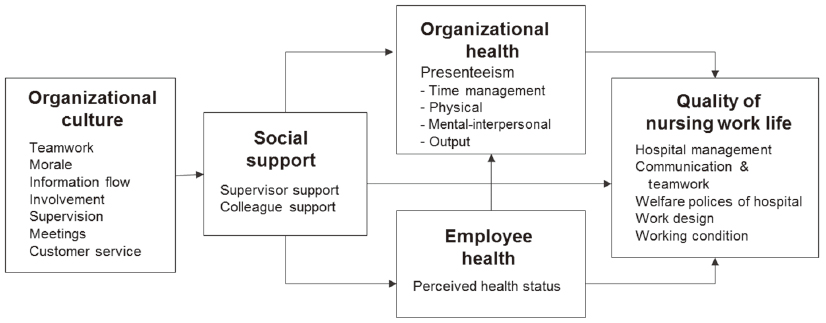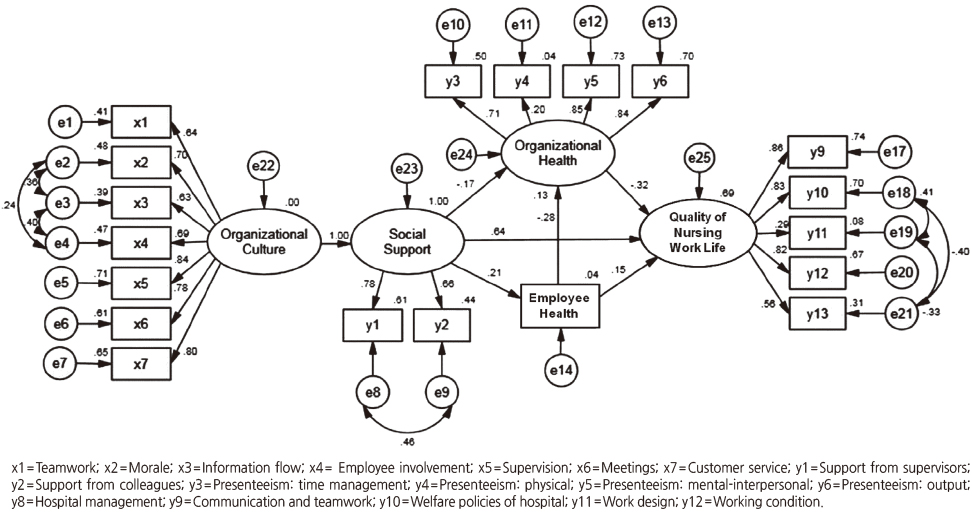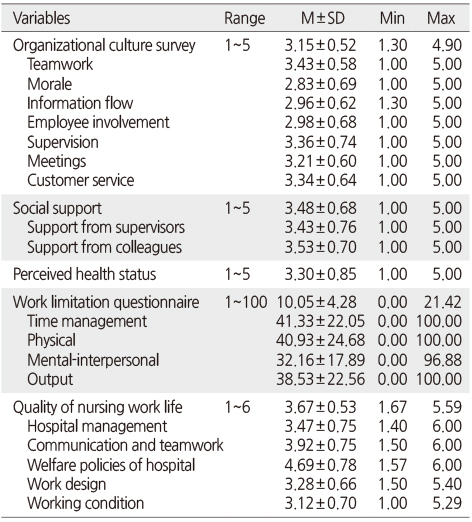Articles
- Page Path
- HOME > J Korean Acad Nurs > Volume 45(6); 2015 > Article
-
Original Article
- Structural Equation Modeling of Quality of Work Life in Clinical Nurses based on the Culture-Work-Health Model
- Miji Kim, Eunjung Ryu
-
Journal of Korean Academy of Nursing 2015;45(6):879-889.
DOI: https://doi.org/10.4040/jkan.2015.45.6.879
Published online: December 31, 2015
1Department of Nursing, Kyungbok University, Pocheon, Korea.
2Department of Nursing, Chung-Ang University, Seoul, Korea.
- Address reprint requests to: Ryu, Eunjung. Department of Nursing, Graduate School, Chung-Ang University, 84 Heuksuk-ro, Dongjak-gu, Seoul 06974, Korea. Tel: +82-2-820-5681 Fax: +82-2-824-7961, go2ryu@cau.ac.kr
© 2015 Korean Society of Nursing Science
This is an Open Access article distributed under the terms of the Creative Commons Attribution NoDerivs License. (http://creativecommons.org/licenses/by-nd/4.0/) If the original work is properly cited and retained without any modification or reproduction, it can be used and re-distributed in any format and medium.
Abstract
-
Purpose
- The purpose of this study was to construct and test a structural equation model of quality of work life for clinical nurses based on Peterson and Wilson's Culture-Work-Health model (CWHM).
-
Methods
- A structured questionnaire was completed by 523 clinical nurses to analyze the relationships between concepts of CWHM-organizational culture, social support, employee health, organizational health, and quality of work life. Among these conceptual variables of CWHM, employee health was measured by perceived health status, and organizational health was measured by presenteeism. SPSS21.0 and AMOS 21.0 programs were used to analyze the efficiency of the hypothesized model and calculate the direct and indirect effects of factors affecting quality of work life among clinical nurses.
-
Results
- The goodness-of-fit statistics of the final modified hypothetical model are as follows: χ2=586.03, χ2/df=4.19, GFI=.89, AGFI=.85, CFI=.91, TLI=.90, NFI=.89, and RMSEA=.08. The results revealed that organizational culture, social support, organizational health, and employee health accounted for 69% of clinical nurses' quality of work life.
-
Conclusion
- The major findings of this study indicate that it is essential to create a positive organizational culture and provide adequate organizational support to maintain a balance between the health of clinical nurses and the organization. Further repeated and expanded studies are needed to explore the multidimensional aspects of clinical nurses' quality of work life in Korea, including various factors, such as work environment, work stress, and burnout.
The authors have no conflict of interest to declare.
This manuscript is based on a part of the first author's doctoral dissertation from Chung-Ang University.
- 1. Kim HG, Ok SY. Conceptualization, development and validation of an organizational well-being scale. J Hum Resour Manag Res. 2010;17(4):325–348.
- 2. Brooks BA, Anderson MA. Defining quality of nursing work life. Nurs Econ. 2005;23(6):319–326.PubMed
- 3. Richard J, Suttle LJ. Improving life at work: Behavioural science approaches to organizational change. Santa Monica, CA: Goodyear Publishing Co.; 1977.
- 4. Kwon M, Kim SL. The job stress and presenteeism of occupational health nurses in workplace in Korea. Korean J Occup Health Nurs. 2010;19(2):159–169.
- 5. Johns G. Presenteeism in the workplace: A review and research agenda. J Organ Behav. 2009;31(4):519–542. ArticlePDF
- 6. Kim M, Choi HO, Ryu E. Predictors of clinical nurses' presenteeism. Korean J Occup Health Nurs. 2014;23(3):134–145. Article
- 7. Davey MM, Cummings G, Newburn-Cook CV, Lo EA. Predictors of nurse absenteeism in hospitals: A systematic review. J Nurs Manag. 2009;17(3):312–330. ArticlePubMed
- 8. Kessler RC, Ames M, Hymel PA, Loeppke R, McKenas DK, Richling DE, et al. Using the World Health Organization Health and Work Performance Questionnaire (HPQ) to evaluate the indirect workplace costs of illness. J Occup Environ Med. 2004;46:6 Suppl. S23–S37. ArticlePubMed
- 9. Peterson M, Wilson JF. The culture-work-health model and work stress. Am J Health Behav. 2002;26(1):16–24. ArticlePubMed
- 10. An JY, Yom YH, Ruggiero JS. Organizational culture, quality of work life, and organizational effectiveness in Korean university hospitals. J Transcult Nurs. 2011;22(1):22–30. ArticlePubMedPDF
- 11. Gifford BD, Zammuto RF, Goodman EA. The relationship between hospital unit culture and nurses' quality of work life. J Healthc Manag. 2002;47(1):13–25. discussion 25-26. ArticlePubMed
- 12. Hsu MY, Kernohan G. Dimensions of hospital nurses' quality of working life. J Adv Nurs. 2006;54(1):120–131. ArticlePubMed
- 13. Argentero P, Miglioretti M, Angilletta C. Quality of work life in a cohort of Italian health workers. G Ital Med Lav Ergon. 2007;29:1 Suppl A. A50–A54.PubMed
- 14. Kellar SP, Kelvin E. Munro's statistical methods for health care research. 6th ed. Philadelphia, PA: Wolters Kluwer Health/Lippincott Williams & Wilkins; 2012.
- 15. Glaser SR, Zamanou S, Hacker K. Measuring and interpreting organizational culture. Manag Commun Q. 1987;1(2):173–198. ArticlePDF
- 16. Kim M. Structural equation modeling of quality of work life in clinical nurse based on the culture-work-health model [dissertation]. Seoul, Chung Ang University. 2015.
- 17. Cobb S. Presidential Address-1976. Social support as a moderator of life stress. Psychosom Med. 1976;38(5):300–314. PubMed
- 18. O'Driscoll MP, Brough P, Kalliath TJ. Work/family conflict, psychological well-being, satisfaction and social support: A longitudinal study in New Zealand. Equal Oppor Int. 2004;23(1-2):36–56. Article
- 19. Lerner D, Amick BC, 3rd , Rogers WH, Malspeis S, Bungay K, Cynn D. The work limitations questionnaire. Med Care. 2001;39(1):72–85. ArticlePubMed
- 20. Ware JE Jr. Scales for measuring general health perceptions. Health Serv Res. 1976;11(4):396–415.PubMedPMC
- 21. Yu JP. The concept and understanding of structural equation modeling. Seoul: Hannare Publishing Co.; 2012.
- 22. Dogbey EA. The relationships among unit culture, work stress, compassion fatigue and sense of wellbeing in operating room nurses in level one or two trauma centers [dissertation]. Chester, PA, Widener University School of Nursing. 2008.
- 23. Baker-McClearn D, Greasley K, Dale J, Griffith F. Absence man agement and presenteeism: The pressures on employees to attend work and the impact of attendance on performance. Hum Resour Manag J. 2009;20(3):311328Article
- 24. Yom YH, Noh SM, Kim KH, Ji SJ, Kim HJ. Development of the evaluation indicators of positive nursing organizational culture in a clinical setting. J Korean Clin Nurs Res. 2013;19(2):233–244.
- 25. Dolan SL, García S, Cabezas C, Tzafrir SS. Predictors of "quality of work" and "poor health" among primary health-care personnel in Catalonia: Evidence based on cross-sectional, retrospective and longitudinal design. Int J Health Care Qual Assur. 2008;21(2):203–218. PubMed
- 26. Shin KR, Cho MO, Kim JS. The meaning of death as experienced by elderly women of a Korean clan. Qual Health Res. 2005;15(1):5–18. ArticlePubMedPDF
- 27. You S. Comparisons of the nursing workforce with Japan, and the U.S. J Digit Converg. 2013;11(6):275–287.
- 28. Lee YW, Dai YT, Park CG, McCreary LL. Predicting quality of work life on nurses' intention to leave. J Nurs Scholarsh. 2013;45(2):160–168. ArticlePubMedPDF
REFERENCES
Figure & Data
REFERENCES
Citations

- Concept Analysis of Presenteeism Among Nurses During the COVID-19 Pandemic
Jiyeon Jung, Jihyun Moon
SAGE Open Nursing.2025;[Epub] CrossRef - The Mediating Effect of Self-Transcendence on the Relationship between Job Stress and Wellness among Nurses
Sung Mi Kim, Da Eun Kim
Journal of Korean Academy of Nursing Administration.2025; 31(4): 394. CrossRef - Influences of Organizational Culture, Nursing Workplace Spirituality, and Nurses’ Perceived Health Status on Quality of Nursing Work Life according to Nursing Clinical Ladder
Hyun Sook Lee, Ju Hyun Jin, Ju Ri Lee, Hye Jin Kim, Yeon Jae Jung
Journal of Korean Academy of Nursing Administration.2024; 30(1): 31. CrossRef - The Effects of Disaster Nursing Core Competence and Coping Flexibility on the Quality of Work Life of Emergency Room Nurses during Long COVID-19
Yu Jin Lee, Chung Hee Woo
Journal of Korean Academy of Nursing Administration.2024; 30(3): 259. CrossRef - Impact of patient‐safety incidents on Korean nurses' quality of work‐related life: A descriptive correlational study
Sun Aee Kim, Taewha Lee
Nursing Open.2023; 10(6): 3862. CrossRef - Employees’ attitudes toward cancer, cancer survivors, and cancer survivors’ return to work
Si Eun Lee, Eun Young Park
Asia-Pacific Journal of Oncology Nursing.2023; 10(3): 100197. CrossRef - The relationships among overcommitment, effort-reward imbalance, safety climate, emotional labour and quality of working life for hospital nurses: a structural equation modeling
Hui Yu Liang, Tzu Yi Tseng, Hung Da Dai, Jin Yun Chuang, Shu Yu
BMC Nursing.2023;[Epub] CrossRef - Latent profile analysis and influence factors study of presenteeism among ICU nurses in China
Yuxin Li, Jijun Wu, Xiaoli Liu, Jiquan Zhang, Xiaoli Zhong, Lin He
Frontiers in Psychology.2023;[Epub] CrossRef - Association of nurses' mental well-being and professional quality of life (ProQOL) to their resiliency during the COVID-19 pandemic crisis
Bader A. Alrasheadi
International Journal of ADVANCED AND APPLIED SCIENCES.2023; 10(2): 182. CrossRef - Factors associated with the quality of work life among working breast cancer survivors
Juhyun Jin
Asia-Pacific Journal of Oncology Nursing.2022; 9(2): 97. CrossRef - Relationship between a University Hospital Nurses’ Structural Empowerment and Quality of Nursing Work Life: Mediating Effect of Psychological Empowerment
Eun Bee Baek, Sun Hyoung Bae
Journal of Health Informatics and Statistics.2022; 47(2): 159. CrossRef - Factors Affecting the Quality of Work Life of Nurses at Tertiary General Hospitals in the Context of the COVID-19 Pandemic
Eunhee Hwang
International Journal of Environmental Research and Public Health.2022; 19(8): 4718. CrossRef - Relationships between self‐efficacy, coping style and quality of work‐life among nursing managers in China: A cross‐sectional study
Cuicui Zhang, Xiyan Gong, Yue Xiao, Ying Zhong, Yali Zhong, Lin Chen, Yao Wang, Lili Zhu, Wanhong Xiong, Changju Liao
Journal of Nursing Management.2022; 30(7): 3236. CrossRef - Structural Equation Model of the Quality of Working Life among Cancer Survivors Returning to Work
Ju Hyun Jin, Eun Ju Lee
Asian Nursing Research.2021; 15(1): 37. CrossRef - Factors Affecting the Quality of Life of Working Cancer Survivors: Based on the 6th and 7th (2014, 2016, 2018) Korean National Health and Nutrition Examination Survey (KNHANES)
Jahyun Choi, Sanghee Kim
Asian Oncology Nursing.2020; 20(4): 171. CrossRef - Nurses’ Fatigue, Job Stress, Organizational Culture, and Turnover Intention: A Culture–Work–Health Model
Eunsook Lee, Insil Jang
Western Journal of Nursing Research.2020; 42(2): 108. CrossRef - Factors Affecting Quality of Work Life in a Sample of Cancer Survivor Female Nurses
Ju Hyun Jin, Eun Ju Lee
Medicina.2020; 56(12): 721. CrossRef - Structural Relationship between Nurses' Occupational Motivation and Effectiveness based on the Job Crafting Model
Mi Suk Hyun
Journal of Korean Academy of Nursing Administration.2020; 26(3): 192. CrossRef - Effect of Workplace Spirituality on Quality of Work Life of Nurse Cancer Survivors in South Korea
Juhyun Jin, Eunju Lee
Asia-Pacific Journal of Oncology Nursing.2020; 7(4): 346. CrossRef - Analysis of Factors Affecting the Quality of Work Life of Dental Hygienists Based on the Culture-Work-Health Model
Ji-Hyeon Park, Young-Sik Cho, Soon-Ryun Lim
Journal of Dental Hygiene Science.2018; 18(1): 32. CrossRef - Clinical Nurses' Resilience Skills for Surviving in a Hospital Setting: A Q-methodology Study
Hye Sook Shin, Ju Hee Kim, Eun Sun Ji
Asian Nursing Research.2018; 12(3): 175. CrossRef - Seafarers’ Quality of Life: Organizational Culture, Self-Efficacy, and Perceived Fatigue
Jae-hee Kim, Soong-nang Jang
International Journal of Environmental Research and Public Health.2018; 15(10): 2150. CrossRef - Quality of Nursing Work Life Scale-Korean: Validity and Reliability
Insook Kim, Hyoungshim Choi, Yeongyi Yim, Seonae Won, Jungwoo Kim, Sanga Lee
Korean Journal of Adult Nursing.2016; 28(6): 646. CrossRef - Structural Equation Modeling of Quality of Work Life in Clinical Nurses based on the Culture-Work-Health Model
Miji Kim, Eunjung Ryu
Journal of Korean Academy of Nursing.2015; 45(6): 879. CrossRef


Figure 1
Figure 2
Descriptive Statistics of Observed Variables (N =523)
Model Fit of the Modified Model
RMSEA=Root mean square error of approximation residual; GFI=Goodness-of-fit index; AGFI=Adjusted goodness-of-fit; TLI=Tucker-Lewis index; CFI=Comparative fit index; NFI=Normed fit index.
Effect of Predictor Variables in the Modified Model
SMC=Squared Multiple Correlation.
RMSEA=Root mean square error of approximation residual; GFI=Goodness-of-fit index; AGFI=Adjusted goodness-of-fit; TLI=Tucker-Lewis index; CFI=Comparative fit index; NFI=Normed fit index.
SMC=Squared Multiple Correlation.
 KSNS
KSNS
 E-SUBMISSION
E-SUBMISSION





 Cite
Cite

